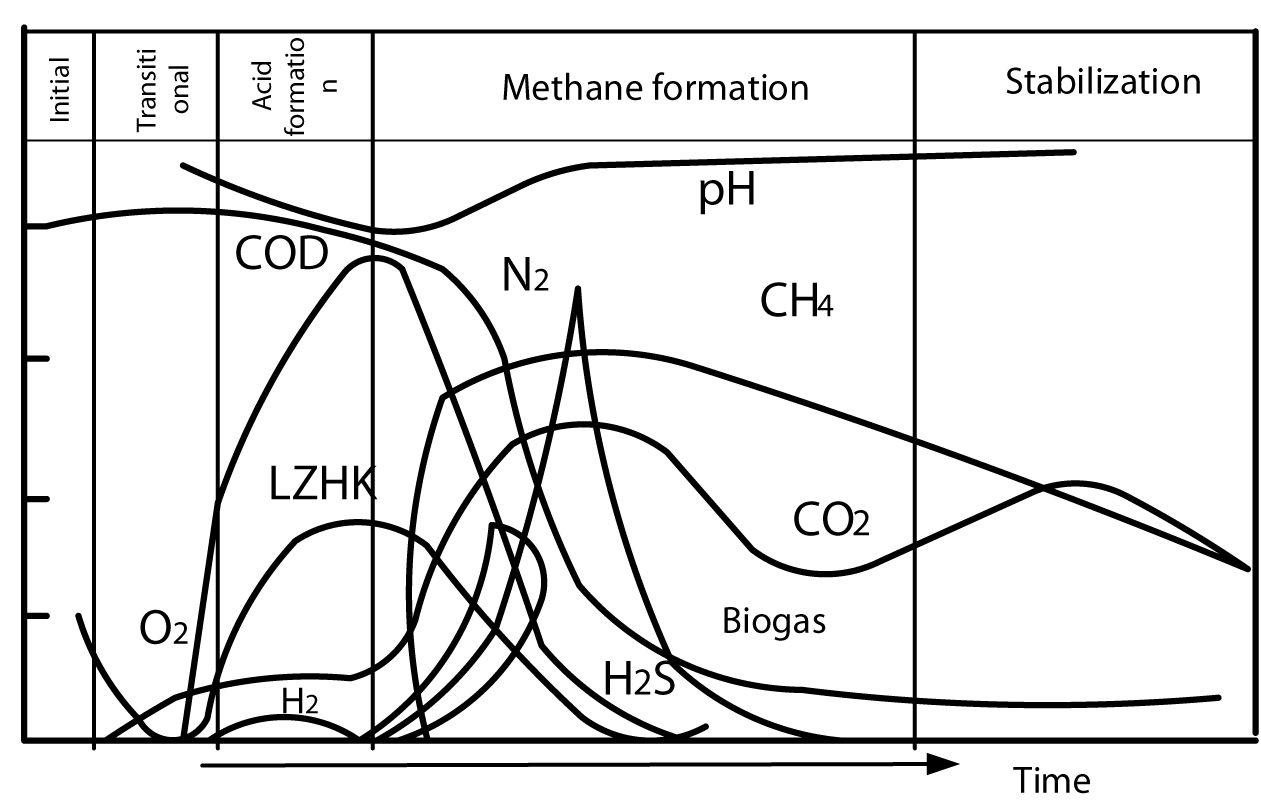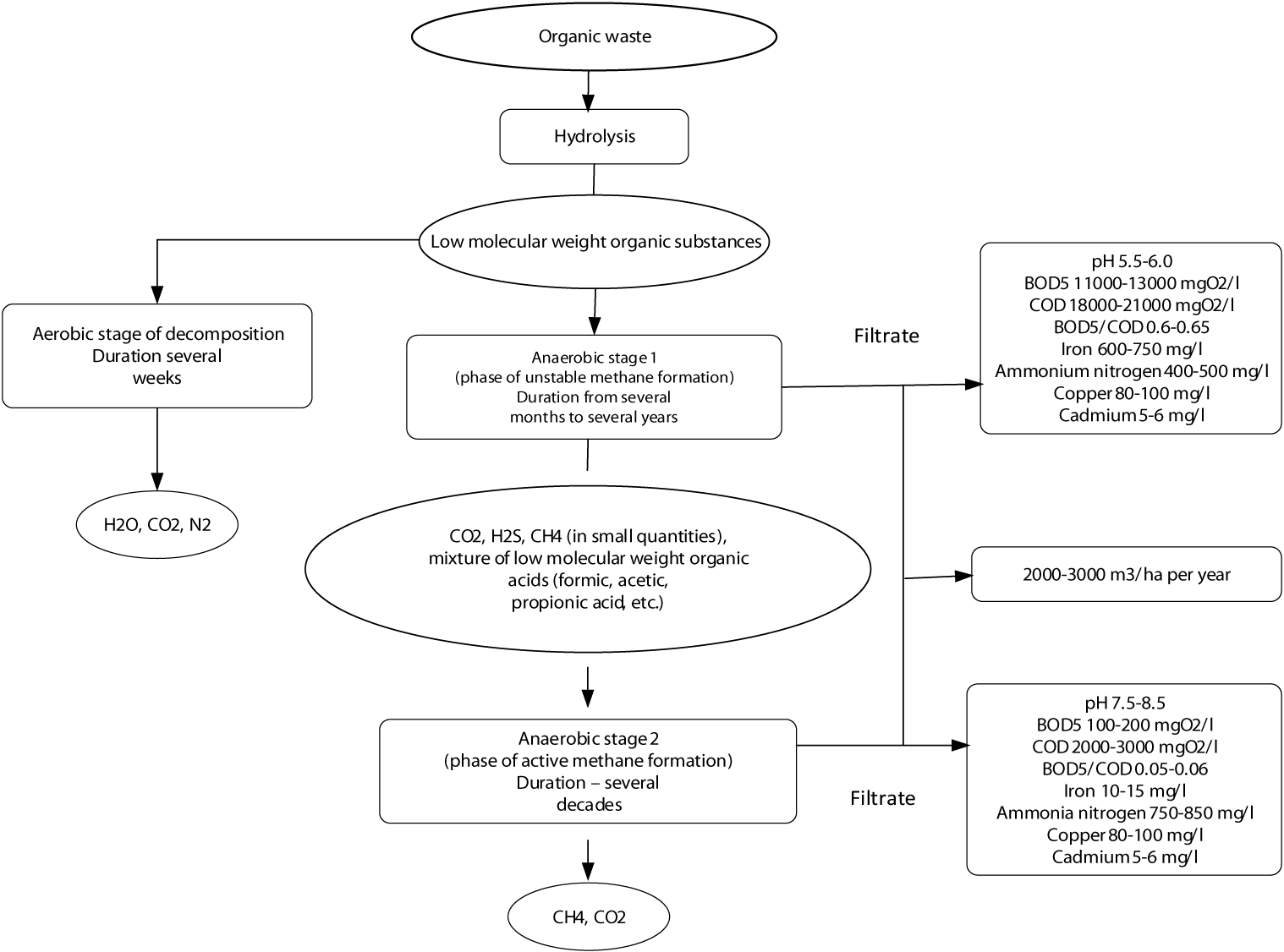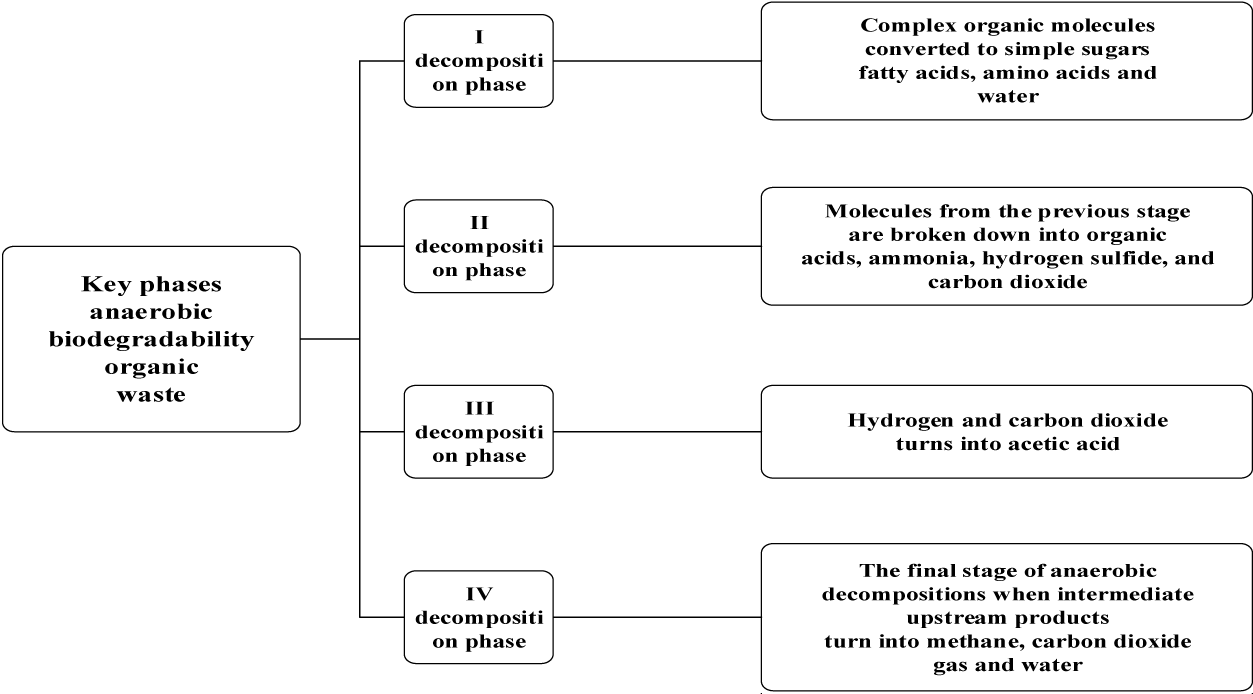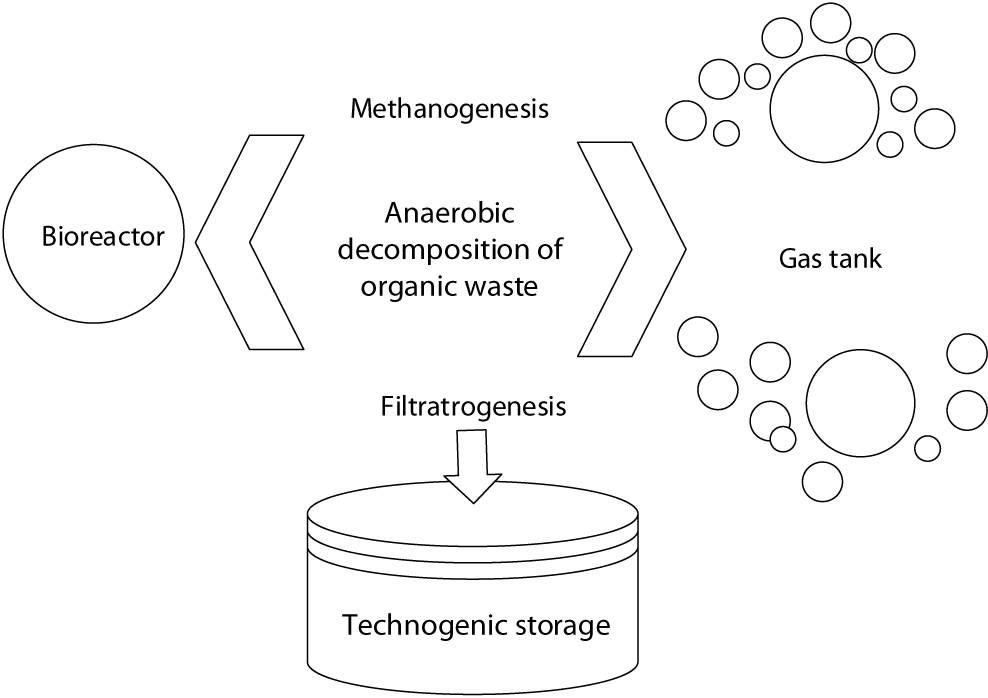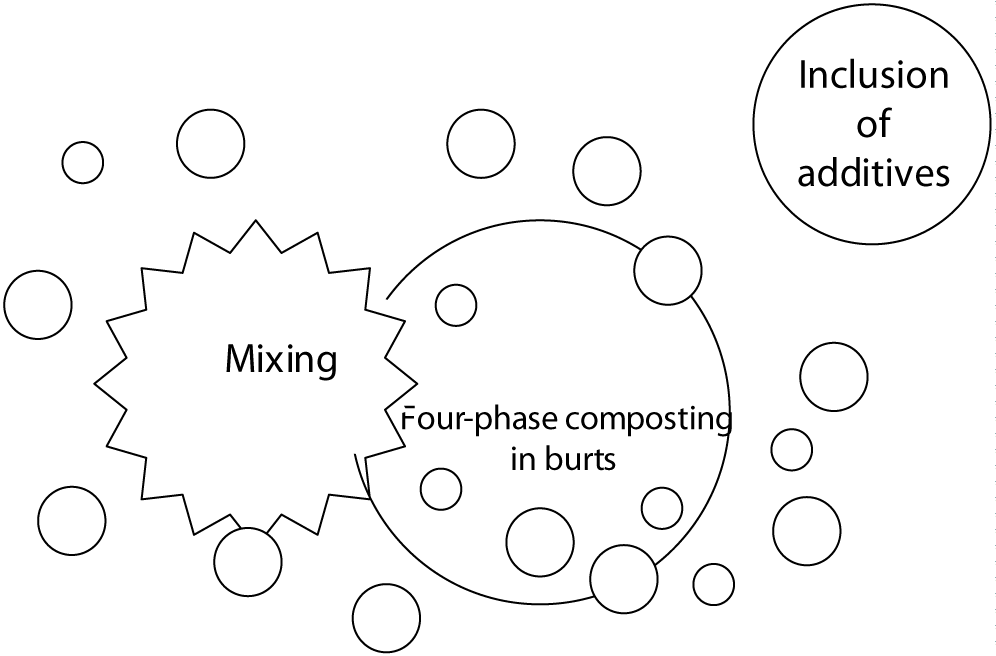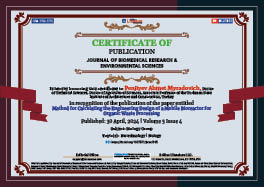Biology Group. 2024 April 30;5(4):392-402. doi: 10.37871/jbres1905.
Method for Calculating the Engineering Design of a Mobile Bioreactor for Organic Waste Processing
Penjiyev Ahmet Myradovich1* and Babaev Meilis Baymyradovich2
2Applicant at the Turkmen State Institute of Architecture and Construction, Turkey
- Organic waste
- Mobile bioreactor
- Aerobic biodegradation
- Anaerobic biodegradation
- Methanogenesis
- Biogas
- Filtrate genesis
Abstract
The article discusses the engineering calculation methodology for developing the design of a mobile bioreactor for processing organic waste. The calculations for processing organic waste were based on SNiP, instructions and methods of leading scientists. When calculating the mobile bioreactor, we took into account: the limit of decomposition of fats, proteins, carbohydrates and the formation of biogas with the density of the mixture. A diagram of the phase process of ongoing and sequential decomposition with the maximum possibility of fermentation for an organic mixture with activated sludge over time, under aerobic and anaerobic conditions during waste disposal, is presented. The advantages and disadvantages of dry and wet waste processing methods are analyzed. From the calculations obtained, we can draw the following conclusion: in a bioreactor with a volume of 7.5 liters, in thermophilic mode, and with a volume of 15 liters, in mesophilic mode, approximately 50% of the organic mixture is fermented, and with activated sludge with a wet substrate, about 95%.
Introduction
Relevance of research
In Turkmenistan, almost all measures are taken to comply with sanitary and hygienic standards for the storage of municipal waste [1]. Approximately 96% of Municipal Solid Waste (MSW) is buried in landfills, authorized and illegal dumps, which, together with the components of the adjacent urban environment, are considered as complex natural-technogenic systems. Processes of biochemical and chemical decomposition of waste occur in the landfill mass, forming emissions of pollutants (in the form of biogas and leachate) that have a negative impact on the biosphere shells, both at the stage of operation of the facility and after its closure and reclamation. The phase processes occurring in the waste disposal area are presented in figure 1 [2-4].
The development of urbanized areas is identified, along with improving the quality of life, with the enrichment of this environment with organic waste, which is produced by the population in the form of solid household organic waste, production facilities in the form of agricultural organic or food waste, and utilities in the form of sewage sludge during their purification and neutralization.
Consequently, the development and introduction into production of modern bioreconstruction methods for processing organic waste are relevant, since they make it possible to manage organic waste in space (from the beginning of their collection to their arrival at industrial technological sites either for centralized neutralization or their use in the form of secondary raw materials for processing ) and in time (biodegradation of organic waste; filtrate genesis, methanogenesis; processes of purification and neutralization of leachate and biogas).
The degree of development of the research topic. The works of Turkmen and foreign scientists made a great contribution to the development of methods for assessing the condition of solid waste disposal sites, to the study of physicochemical and biochemical processes of waste destruction, emissions of pollutants into the components of the biological environment [4-20].
Despite the significant amount of scientific research carried out in foreign countries, a difficult task that has not yet been solved unambiguously is the determination of the physicochemical and biochemical parameters of waste of different disposal periods and the establishment of parameters for achieving stability of waste in the disposal area. The developed methods for assessing the condition of the solid waste disposal site, as an element of the PTS, are labor-intensive and time-consuming. The advantages and disadvantages of dry and wet methods of waste processing and calculations for developing the design volume of a mobile bioreactor in thermophilic and mesophilic modes of fermentation of an organic mixture with activated sludge and substrate moisture have not been sufficiently analyzed.
Objects of research
Organic waste agricultural, food and organic waste as part of municipal solid waste.
Subject of research
Processes of aerobic and anaerobic biodecomposition of organic waste in a mobile bioreactor.
Purpose and objectives of the study
Study the phase processes of decomposition, fermentation, make calculations for the development of technology for processing organic waste, taking into account the limit of decomposition of fats, proteins, carbohydrates and the formation of biogas with the density of the mixture; to develop the design of a mobile bioreactor.
Scientific novelty
The advantages and disadvantages of dry and wet waste processing methods are analyzed. Volumetric calculations of a mobile bioreactor in thermophilic and mesophilic modes for the fermentation of an organic mixture with activated sludge and substrate moisture were obtained.
Practical significance
The obtained calculations of mobile bioreactors can be used to develop the engineering design of a mobile bioreactor for processing organic waste in individual enterprises, small farms and municipal enterprises serving small settlements that are interested in processing organic waste and producing biogas.
Schematic diagram for assessing the condition of a solid waste disposal site and its impact on the environment
The negative impact of solid waste disposal sites is associated with the intense occurrence of physical, chemical and biochemical processes in the waste mass, which results in the decomposition of complex organic substances and the formation of pollutant emissions [22,23]. The long-term danger of a landfill is determined by the period of time during which the waste buried in the landfill is potentially dangerous [19].
The decomposition processes of buried waste occur sequentially under aerobic and anaerobic conditions. The principal processes of decomposition of organic substances during waste disposal at landfills are presented in figure 2 [24].
In the early stages of landfill operation (up to 1 year), waste undergoes aerobic biodegradation. The duration of the aerobic phase depends on the pretreatment and method of disposal of solid waste. Aerobic processes usually proceed faster and are accompanied by a large amount of heat generated [21,23,25]. Under aerobic conditions (at a depth of 50-80 cm), hydrolysis and oxidation of food waste containing fats, proteins, and proteins occurs quite quickly [20,24-26]. As oxygen reserves are used up, the activity of aerobic processes decreases and anaerobic processes caused by the activity of anaerobic microorganisms begin to predominate in buried solid waste. The main products of aerobic processes are carbon dioxide and water [20,24].
Biodegradation is a complex biochemical process that sequentially combines chemical, physicochemical reactions that involve various types of aerobic and anaerobic microorganisms. They potentially process organic waste and produce compost when biodegraded aerobically and renewable energy when biodegraded anaerobically [5].
During biodegradation under the influence of various groups of microorganisms, complex organic substances break down into simpler ones. The biodegradation process ensures: recycling of waste by reducing its volume and weight; production of biodegradation products - compost during aerobic processing and biogas during anaerobic processing, which, in turn, can be used in solving key anthropogenic problems, such as bioremediation of anthropogenically disturbed ecosystems during compost production and the production of renewable energy in the form of thermal or electrical energy during biogas production.
Anaerobic decomposition of organic waste
- consists of a series of complex microbial reactions, including harmonious competition and syntrophy for their substrates during the processes of biotransformation of hydrolysis, acidogenesis and methanogenesis [6];
- widely practiced as a reliable mechanism of biochemical transformation [7];
- biological processing, considered as an alternative energy source due to the large amount of energetically valuable methane in biogas, instead of using fossil fuels [7];
- Is an effective technology for improving the use of renewable energy and at the same time reducing greenhouse gas emissions [8];
- can be used for both processing solid and liquid substrates [8];
- used not only for anaerobic stabilization of sludge in wastewater treatment plants, but also in co-fermentation processes with other organic substrates, such as the organic fraction of solid household or industrial waste [8];
is a biological process by which organic matter is converted into methane and carbon dioxide in the absence of oxygen [9];
- a complex process where mutual exchanges of substrates and products take place between the solid, liquid and gas phases [9];
- the direction of biotechnology, which has received increased attention compared to other disposal options, as a means of stabilizing the biodegradable part of organic waste [10];
- as a biological process in which organic carbon, as a result of oxidation-reduction reactions, is converted into both the most oxidized state (CO2) and the most reduced form (CH4) [11];
- microbiological process of decomposition of organic substances in the absence of air [12];
- the process refers to biological treatment that can decompose and stabilize a wide range of organic wastes, from complex lignocellulosic materials to easily degradable food waste, while producing renewable energy, recovering fiber and nutrients for soil biota and offsetting greenhouse gas emissions [13];
- a well-proven technology that converts the organic fraction into a renewable fuel such as methane [13].
Summarizing the above, we can conclude that anaerobic decomposition is a complex biochemical process that occurs in the absence of air and which sequentially combines chemical and physicochemical reactions, including various types of microorganisms, which, in turn, allow the decomposition and stabilization of a wide range of organic wastes.
Anaerobic decomposition of organic waste proceeds technologically, according to the authors [14-17], in four phases - hydrolysis, acetogenesis, acidogenesis, methanogenesis, which together culminate in syntrophic interactions of various microorganisms; according to others [18], two phases are distinguished: in the first, hydrolysis occurs, acidification and liquefaction, and in the second, acetate, hydrogen and carbon dioxide are converted into methane, and according to third groups of authors [7,18] there are three phases: bacterial decomposition, volatilization and the chemical reaction phase [7]
Hydrolysis is known as the stage where complex organic compounds, such as lignocellulosic materials, undergo very slow decomposition [17], so the stage limits not only the speed of the process, which determines the duration of the splitting process [5], but also the rate of biogas production [10].
During this stage, the following transformation of substances occurs:
Anaerobic decomposition mainly focuses on volume reduction
- a large initial amount of solid organic fraction is converted into a liquid state (through hydrolysis),
- after this, various microorganisms convert this liquid into volatile fatty acids and alcohols (through acidogenesis),
- at the last stage, these acids and alcohols are converted into gases, primarily into CO2 and CH4 (through methanogenesis).
Acetogenesis
preceding the methanogenesis phase, plays a decisive role in anaerobic decomposition:
- fermentative bacteria primarily decompose polysaccharides to monosaccharides or glucose by hydrolysis, which are then converted into fatty acids, alcohols and H2 , CO2 due to acidogenesis [19].
Figure 3 shows the key phases of the anaerobic decomposition process.
From figure 3 we see that during hydrolysis, carbohydrates, proteins and fatty acids are converted into simpler and soluble molecular compounds, such as sugars, amino acids and fatty acids; during acidogenesis, for example, sugars, amino acids and fatty acids are converted into organic acids or volatile fatty acids acids, alcohols and some inorganic compounds, such as CO2 , H2 , H2S and NH3 , in turn, acetogenic bacteria during acetogenesis convert acidogenesis products into acetate, hydrogen and carbon dioxide [17]. In methanogenesis, the biodegradation of organic waste is achieved through a series of biochemical transformations that can be divided into a first stage, where hydrolysis, acidification and liquefaction occur, and a second stage, where acetate, hydrogen and carbon dioxide are converted to methane [18].
Anaerobic digestion on an industrial scale is characterized by two technologies: wet and solid-state.
Difference in solids concentration (below or above 15%, respectively). Wet anaerobic digestion and solid state anaerobic digestion are considered to be the two main types of anaerobic technologies that have been used to process organic solids for the purpose of producing biogas. The classification between these two technologies is mainly based on the specific content of total solids concentration below or above 15%, respectively [13].
There are mainly two types of fermentation processes used: wet and dry.
In the first case, the biomass entering the digester has a solids concentration below 12%, while in dry processing plants the solids concentration exceeds 20%. All wet fermentation processes occur continuously, while dry fermentation adopts both batch and continuous processes [16] (Table 1).
| Table 1: Half-life and biodegradation factor of various types of waste [28,29]. | |||||
| Type of waste | Name of waste | Half-life under decomposition conditions | Bio digestion factor provisions | ||
| Wet | Average | Dry | |||
| Quickly laid down | Food waste, disposable paper tableware, magazine paper | 3 years | 7 years | 15 years | 0.83 |
| Average time laid down | Polymer film, polymer packaging, office paper, vegetable waste | 7 years | 15 years | 25 years | 0.6 0.72 |
| Slowly degradable | Corrugated cardboard, newsprint, wood | 15 years | 25 years | 50 years | 0.22 |
Advantages of the dry processing method
- there is no need for mixers inside the reactor;
- strength and resistance to heavy inert materials and plastics;
- no hydraulic short circulation low loss of biodegradable
organic matter during pre-treatment;
- a high organic load factor is used. Resistance to peak concentrations of substrate or toxic substances;
- minimal and economical pre-treatment. Reactor volumes have been reduced;
- limited use of fresh water. Minimum request for reactor heating.
Disadvantages of the dry processing method
- waste with low solid content;
- minimal possibility of dilution;
- inhibitory substances and excessive organic loads with fresh water;
- waste with low moisture content (< 20% of total solids) is processed together with other wet waste;
- high investment costs due to the equipment used for processing.
Comparing with other technologies, we can say the following:
Comparison with combustion. In general, the use of incineration to manage the organic fraction of municipal solid waste shows higher environmental benefits compared to anaerobic digestion and composting, mainly due to the higher amount of energy recovered. This was significantly influenced by the environmental effect caused by the avoidance of emissions to produce energy from an energy mix consisting mainly of fossil fuels. In addition, the composting and anaerobic digestion scenario indicates the generation of biogenic emissions with a high level of global warming potential [27].
Calculation of the engineering design of a mobile bioreactor for processing organic waste
Calculation of the engineering design of a mobile bioreactor for processing organic waste was carried out using SNiP [28], instructions [29] and methods prescribed in the works of [30-32]. When calculating a mobile bioreactor, the following should be taken into account:
1) limits of breakdown of fats (70%), proteins (48%) and carbohydrates (63%);
2) The formation of biogas during the biodecomposition of fats, proteins and carbohydrates: with 1 g, 1.31 g is produced from fat, 0.71 g from proteins and 0.985 g from carbohydrates, respectively, with a specific biogas yield of 1250, 704 and 790 ml/g;
3) Composition of biogas CH4 and CO2 : 68/32; 71/29 and 50/50 respectively.
Conventional chemical formula of biogas:
Biogas = CH4 (up to 80%) + CO2 (up to 60%) + H2S (up to 3%) + H2 (up to 1%) + “traces” of other gases” (gas density: 1) [32].
The limit of anaerobic biodegradation of organic waste (a, %) from 1 g of substrate (0.7 F; 0.48 B; 0.625 U) is determined by formula 1:
a = (1.31 ∙ 0.7 fats) + (0.71 ∙ 0.48 proteins) + (0.985 ∙ 0.625 carbohydrates) (1)
Loading dose:
a) By volume (%) use the daily volume of loading substrate into the digester:
P = 100/D, (2)
Where: P – duration of anaerobic biodegradation; D – loading volume.
b) For ash-free substance Dbz (kg/m3 of digester).
In practice, a linear and power-law dependence of the degree of decomposition of fats, proteins and carbohydrates (in the complex - ash-free substance or b.v.) on the loading dose of the digester is used.
Straight-line dependence [30-33]:
y = (a – nD)/100, (3)
where n is the experimentally obtained coefficient, depends on humidity (W%) and temperature (t°C); y is the yield of biogas, m3/kg loaded into the waste digester; D daily loading dose, %.
The necessary data for the calculation are presented in table 2.
| Table 2: Values of coefficient d, n, identified experimentally [30]. | ||||
| W% | D% | N% | ||
| Temperature: Mesophilic | Temperature mode: Thermophilic | Temperature mode: Mesophilic | Temperature: Thermophilic | |
| 93 | 7 | 14 | 1.05 | 0.455 |
| 94 | 8 | 16 | 0.89 | 0.385 |
| 95 | 9 | 18 | 0.72 | 0.31 |
| 96 | 10 | 20 | 0.56 | 0.24 |
| 97 | eleven | 22 | 0.4 | 0.17 |
Consumption of organic mixture, kg/day:
Odry = Ceq /1 ∙ 1 , (4)
Where C is the concentration (initial) of suspended solids, 890 mg/l; E - effect of retention of suspended substances, 0.5 dollars. Units; K- coefficient for taking into account the increase in the volume of the organic mixture, 1.1; Q is a one-time influx of organic mixture, therefore an intermittent waste processing method is used.
As a result, the consumption of the organic mixture is 1.96 l/day.
Excess consumption, we determine I dry, l/day:
And dry = C(1−E) n −b1 ∙ Q , (5 )
Where n – coefficient is 1.15; b1 - removal of activated sludge, 15 mg/l. The consumption of excess sludge is 1.17 l/day.
Consumption of ash-free substance of organic mixture, kg/day
О bz = О dry (100−В r )(100−З ос)/100∙100 ( 6)
And bz = And dry (100−В) (100−З silt)/100∙100 (7)
Hygroscopic humidity (%) of raw sludge (Br) and excess activated sludge (Br) is 5-6%; the consumption of ash-free organic matter of the mixture is Obz = 2.98 kg/day.
The ash content of the dry matter (%) of the wet sludge (Zos) and activated sludge (Sl) is 25-27%. The consumption of the ash substance of the organic mixture is equal to Ibz = 1.80 kg/day
Raw sludge consumption, l/day:
V os = 100 O dry /(100− W os )R os , (8)
where Woc - humidity of wet sediment, 93-95%; W sludge - humidity of compacted activated sludge, 96.5-97.5%; Pos - density of wet sediment, l3 / day; Rsl - activated sludge, for simplicity, taken as 1. The consumption of raw sludge is 59.7 l3 / day.
Consumption of excess activated sludge, l/day:
V= 100 And dry(100− Wsilt) R silt. (9)
The consumption of excess activated sludge is 75.1 l / day
Total consumption of raw sludge and excess activated sludge:
By dry matter, kg/day
M dry = O dry + I dry (10)
For dry matter M dry = 6.81 kg/day.
By ash-free substance, kg/day
M bz = O bz + I bz (11)
For ash-free substance M bz = 4.78 kg/day.
By mixture consumption of actual humidity, l/day
M total = V os + V silt (12)
According to the consumption of the mixture of actual humidity Mtot = 1.35 l/day.
Average substrate humidity, ash content, bioreactor loading volume and dose:
Average humidity of organic mixture, %
In cm =100 (1 − O dry + I dry / V os + V silt ) . (13)
The average humidity of the organic mixture is V cm = 95%.
Average ash content of absolutely dry matter of the organic mixture, %
Z cm =100 [1 − O be + I be /Oduh (100−r)/100+Iduh(100−Vr )/100]. (14)
The average ash content of absolutely dry matter of the organic mixture is 3 cm = 74%.
Bioreactor volume, l
W = M total ∙ 100/D, (15)
Where Mtot is the amount of substrate entering the bioreactor per day, m 3 ; D - daily dose, (%); the dose when loading a bioreactor is 9%, when loading a mesophilic one it is 18%;
Bioreactor volume: in thermophilic mode W=15 l; in mesophilic mode W=7.5 l in thermophilic mode
Bioreactor loading dose, %
D = 10 / qC (100− ), (16)
where q is the maximum permissible load, g/m3 , for surfactants (40 g/m3 for alkyl sulfatones, 85 g/m3 for anionic ones); C – surfactant concentration in the organic mixture (loaded), mg/g; B – humidity of the organic mixture, %.
When the surfactant content in the organic mixture of dry matter is: 11-13 mg/g (mesophilic mode) and 6-7 mg/g (thermophilic mode), D = 15.5% for the mesophilic mode and D = 28.3% for the thermophilic mode.
Maximum possible digestion for organic mixture with activated sludge
a cm = ( a o O bz + a and I bz )/M bz (17)
For an organic mixture a o = 53%, and for excess activated sludge a u = 44%.
The maximum possible fermentation for an organic mixture with activated sludge is a cm = 49.6%.
The results obtained and the methodology for calculating the bioreactor are based on experimental data. Based on the calculations obtained, we can draw the following conclusion: in a bioreactor with a volume of 7.5 liters in thermophilic mode and a volume of 15 liters in mesophilic mode, approximately 50% of the organic mixture is fermented, and with activated sludge and substrate moisture - about 95%.
Technological scheme for processing organic waste in a mobile bioreactor
Biotechnology of organic waste processing based on the use of a mobile bioreactor involves performing the procedures that are presented in the form of a block diagram in figures 4 & 5.
The anaerobic decomposition bioreactor, according to SNiP and the calculated and experimental studies carried out, will consist of components presented at the fourth stage of the block diagram (Figure 3).
As shown in figure 3, the main engineering and design solutions for ensuring anaerobic biodegradation of organic waste are three components: a bioreactor (methane tank), a gas tank and a technogenic storage device:
A mobile methane tank is a container that performs three tasks for the successful anaerobic decomposition of organic waste:
- provides tightness in order to prevent oxygen from entering the decomposed substrate, which accelerates the process, so the material used for the construction of the bioreactor tank must be heat-resistant;
- Thanks to the installed hoses on top of the lid and bottom of the bioreactor, it provides the output of biodegradation products – biogas to the gas tank and filtrate to the technogenic storage tank, respectively.
The gas tank designed for collecting biogas is sealed and has three outlet channels:
1) Two channels are located on the bottom at opposite poles:
- the first one connects the gas tank to the bioreactor,
- the second connects the gas tank to the outlet
2) One outlet channel is located on the cover and is intended for removing biogas from the gas tank.
The technogenic storage tank is connected to the bioreactor body through a hermetically installed hose and is intended for collecting filtrate. After anaerobic biodegradation of organic waste, digestate remains in the bioreactor, which is proposed to be used for compost production.
The bioreactor for aerobic biodegradation of organic waste, in particular digestate, according to SNiP [28] and the conducted studies will consist of components presented at the fifth stage of the flowchart of figure 4.
As can be seen from figure 3, the main engineering and design solution for ensuring the aerobic biodegradation of organic waste (digestate) is the presence of a container in the form of a shoulder. Other processes that provide solid-phase aerobic fermentation, such as the supply of oxygen and various bioadditives to enrich the compost with oxygen and beneficial microflora, can be carried out mechanically without incurring additional capital costs in order to reduce the cost of the processes.
Conclusion
The main engineering and design solutions in ensuring anaerobic biodecomposition of organic waste are three components - a bioreactor (digester), a gas holder and a technogenic storage tank.
The main engineering solution for ensuring aerobic biodecomposition of organic waste (digestate) is the presence of a container in the form of a pile. The remaining processes that ensure solid-phase aerobic fermentation, such as the supply of oxygen and various bioadditives in order to enrich the compost with oxygen and beneficial microflora, can be carried out mechanically without involving, in order to reduce the cost of processes, additional capital costs.
Based on computational and experimental studies, a five-stage biotechnology for processing organic waste based on the use of a mobile bioreactor has been developed.
The following conclusions are drawn
- Disposal of residues in landfills made a significant contribution to the environmental burden of the composting and anaerobic digestion scenario;
- burning waste is advisable from the point of view of obtaining thermal energy;
- If incineration is not possible due to excessive costs, composting is in any case recommended, provided that the waste is treated differently than landfill [20].
Based on the calculations obtained, we can draw the following conclusion: in a 7.5-liter bioreactor in thermophilic mode and in a 15-liter bioreactor in mesophilic mode, approximately 50% of the organic mixture is fermented, and with activated sludge with substrate moisture - about 95%.
References
- Berdimuhamedov GM. Turkmenistan is on the path to achieving the sustainable development goals. Ashgabat: Turkmen State Publishing Service. 2018.
- Penjiyev AM. Eco-energy resources of renewable energy sources: Monograph. 2023.
- Penjiyev AM. Green industrialization. Germany: Lap lambert Academic Publishing. 2016.
- Penjiyev AM. Ecological problems of desert development: Monograph. Germany: Lap lambert Academic Publishing. 2014.
- Zulkifli AA, Mohd Yusoff MZ, Abd Manaf A, MR, Roslan AM, Ariffin H, Shirai Y, Hassan MA. Assessment of municipal solid waste generation in university putra Malaysia and its potential for green energy production. Sustainability. 2019;11(14):3909-3909. doi: 10.3390/su11143909.
- Zamotaev IV, Ivanov IV, Mikheev PV, Belovrov VP. Assessment of the state of soils and vegetation in areas of landfills and municipal solid waste sites (a review). Eurasian Soil Science. 2018;51(7):827-842. doi: 10.1134/S1064229318070104.
- Khairuddin N, Abd Manaf L, Hassan MA, Halimoon N, Ab Karim WAW. Biogas harvesting from organic fraction of municipal solid waste as a renewable energy resource in Malaysia: A Review. Polish Journal of Environmental Studies. 2015;24(4):1477-1490. doi: 10.15244/pjoes/34670.
- Mainardis M, Cabbai V, Zannier G, Visintini D, Goia D. Characterization and bmp tests of liquid substrates for high-rate anaerobic digestion. Chemical and Biochemical Engineering Quarterly. 2017;31(4):509-518. doi: 10.15255/CABEQ.2017.1083.
- Fernandes A, Jesus T, Silva R, Pacheco MJ, Ciriaco L, Lopes A. Effluents from anaerobic digestion of organic wastes: treatment by chemical and electrochemical processes. Water, Air & Soil Pollution. 2017;228(11):1-8. doi: 10.1007/s11270-017-3620-1.
- Mlaik N, Khcharem M, Kouas M, Sayadi S, Khoufi S. Improvement of anaerobic biodegradability of organic fraction of municipal solid waste by mechanical and thermochemical pretreatments. Int J Environ Sci Technol. 2018;15:1913-1920. doi: 10.1007/s13762-017-1563-0.
- Jimenez J, Latrille E, Harmand J, Robles A, Ferrer J, Gaida D, Wolf C, Mairet F, Bernard O, Alcaraz-Gonzalez V, Mendez-Acosta H, Zitomer D, Totzke D, Spanjers H, Jacobi F, Guwy A, Dinsdale R, Premier G, Mazhegrane S, Ruiz-Filippi G, Seco A, Ribeiro T, Pauss A, Steyer J P. Instrumentation and control of anaerobic digestion processes: A review and some research challenges. Rev Environ Sci Biotechnol. 2015;14:615-648. doi 10.1007/s11157-015-9382-6.
- Stan C, Collaguazo G, Streche C, Apostol T, Cocarta DM. Pilot-scale anaerobic co-digestion of the ofmsw: Improving biogas production and startup. Sustainability. 2018;10(6):1939. doi: 10.3390/su10061939.
- Sayara, T, Sánchez A. A review on anaerobic digestion of lignocellulosic wastes: Pretreatments and operational conditions. Applied Sciences. 2019;9(4655):1-23. doi:10.3390/app9214655.
- Li L, He Q, Ma Y, Wang X, Peng X. A mesophilic anaerobic digester for treating food waste: Process stability and microbial community analysis using pyro sequencing. Microbial Cell Factories. 2016;15(65):1-11. doi: 10.1186/s12934-016-0466-y.
- Gao Y, Kong X, Xing T, Sun Y, Zhang Y, Luo X, Sun Y. Digestion performance and microbial metabolic mechanism in thermophilic and mesophilic anaerobic digesters exposed to elevated loadings of organic fraction of municipal solid waste. Energies. 2018;11(4):952. doi: 10.3390/en11040952.
- Ranieri L, Mossa G, Pellegrino R, Digiesi S. Energy recovery from the organic fraction of municipal solid waste: A real options-based facility assessment. Sustainability. 2018;10:1-15. doi:10.3390/su10020368.
- Richard EN, Hilonga A, Machunda RL, Njau KN. A review on strategies to optimize metabolic stages of anaerobic digestion of municipal solid wastes towards enhanced resource recovery. Sustainable Environment Research. 2019; 29(36):1-13. doi: 10.1186/s42834-019-0037-0.
- Rajagopal R, Bellavance D, Rahaman MdS. Psychrophilic anaerobic digestion of semi-dry mixed municipal food waste: For North American context. Process Safety and Environmental Protection. 2017;105:101-108. doi: 10.1016/j.psep.2016.10.014.
- Chatterjee B, Mazumder D. Anaerobic digestion for the stabilization of the organic fraction of municipal solid waste: A review. Environmental Reviews. 2016;24(4):426-459. doi: 10.1139/er-2015-0077.
- Kang J, Kwon G, Nam JH, Kim YO, Jahng D. Carbon dioxide stripping from anaerobic digestate of food waste using two types of aerators. International Journal of Environmental Science and Technology. 2017;14:1397-1408. doi: 10.1007/ s 13762-017-1250-1.
- Shubarkol. The black pearl of Sary-Arka.
- Shishelova TI. Samuseva MN, Shenkman BM. Using ASW as a sorbent for wastewater treatment. Modern Science Intensive Technologies. 2008;5:20-22.
- Orlov DS. Soil chemistry. 1985.
- Musina USh. News of the St. Petersburg State Technological Institute. 2014;23(49):79-82.
- Musina USh. Ecological potential of Koksu shungite. Hydrometeorology and Ecology. 2010;4:154-159.
- Musina USh. Study of the bleaching ability of Koksu shungite rocks. Bulletin of KazNTU. 2011;1(83):85-90.
- Musina USh. Study of the physico-chemical properties of Koksu shungite rocks. Bulletin of KazNTU. 2010;6(82):3-7.
- Musina USh, Kozmin NB, Kutybaev NR, Nurdildanova BE. Study of the influence of koksu shungite (taurite) on the oxygen content in aqueous solutions. Bulletin of KazNTU. 2012;1(89):221-225.
- External networks and sewerage.
- Abramov NF, Vaisman YaI, Maksimova SV, Glushankova IS, Batrakova GM, Vaisman OYa, Korotaev VLN. Rudakova LVM, Gosstroy RF. Recommendations for calculating the formation of biogas and choosing degassing systems for solid waste disposal sites. 2003.
- Yakovlev SV, Karelin YaA, Zhukov AI, Kolobanov SK, Sewerage. 5th ed. Stroyizdat M, editor. 1975.
- Kovalev NG, Pogrebnaya NP, Egorova OG. Cleaning and disposal on cattle farms. Animal Husbandry. 1981;2:20-22.
- Voronov YV, Yakovlev SV. Water disposal and wastewater treatment. Publishing House of the Association of Construction Universities. 2006.
Content Alerts
SignUp to our
Content alerts.
 This work is licensed under a Creative Commons Attribution 4.0 International License.
This work is licensed under a Creative Commons Attribution 4.0 International License.





